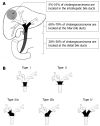Surgical strategy for bile duct cancer: Advances and current limitations
- PMID: 21603318
- PMCID: PMC3095469
- DOI: 10.5306/wjco.v2.i2.94
Surgical strategy for bile duct cancer: Advances and current limitations
Abstract
The aim of this review is to describe recent advances and topics in the surgical management of bile duct cancer. Radical resection with a microscopically negative margin (R0) is the only way to cure cholangiocarcinoma and is associated with marked survival advantages compared to margin-positive resections. Complete resection of the tumor is the surgeon's ultimate aim, and several advances in the surgical treatment for bile duct cancer have been made within the last two decades. Multidetector row computed tomography has emerged as an indispensable diagnostic modality for the precise preoperative evaluation of bile duct cancer, in terms of both longitudinal and vertical tumor invasion. Many meticulous operative procedures have been established, especially extended hepatectomy for hilar cholangiocarcinoma, to achieve a negative resection margin, which is the only prognostic factor under the control of the surgeon. A complete caudate lobectomy and resection of the inferior part of Couinaud's segment IV coupled with right or left hemihepatectomy has become the standard surgical procedure for hilar cholangiocarcinoma, and pylorus-preserving pancreaticoduodenectomy is the first choice for distal bile duct cancer. Limited resection for middle bile duct cancer is indicated for only strictly selected cases. Preoperative treatments including biliary drainage and portal vein embolization are also indicated for only selected patients, especially jaundiced patients anticipating major hepatectomy. Liver transplantation seems ideal for complete resection of bile duct cancer, but the high recurrence rate and decreased patient survival after liver transplant preclude it from being considered standard treatment. Adjuvant chemotherapy and radiotherapy have a potentially crucial role in prolonging survival and controlling local recurrence, but no definite regimen has been established to date. Further evidence is needed to fully define the role of liver transplantation and adjuvant chemo-radiotherapy.
Keywords: Adjuvant chemotherapy; Adjuvant radiation; Bile duct cancer; Cholangiocarcinoma; Hepatectomy; Liver transplantation; Pancreaticoduodenectomy; Surgery.
Figures


References
-
- de Groen PC, Gores GJ, LaRusso NF, Gunderson LL, Nagorney DM. Biliary tract cancers. N Engl J Med. 1999;341:1368–1378. - PubMed
-
- Lazaridis KN, Gores GJ. Cholangiocarcinoma. Gastroenterology. 2005;128:1655–1667. - PubMed
-
- Greene FL, Page DL, Flemming ID. AJCC (American Joint Committee on Cancer) Cancer staging Manual. 6th ed. New York: Splinger-Verlag; 2002.
-
- Japanese Society of Biliary Surgery. Classification of biliary tract carcinoma. 2nd English ed. Tokyo: Kanehara; 2004.
LinkOut - more resources
Full Text Sources

